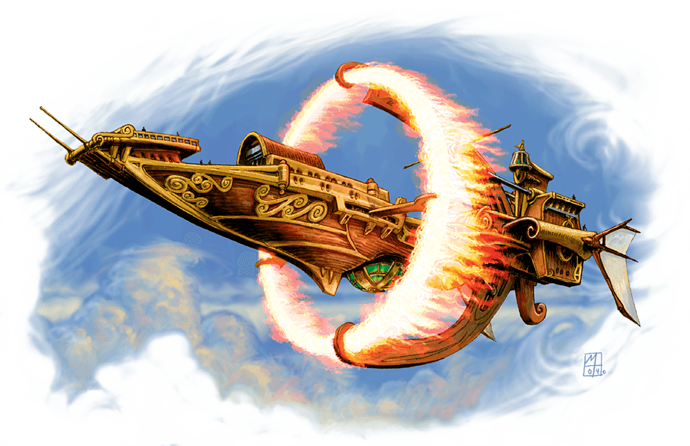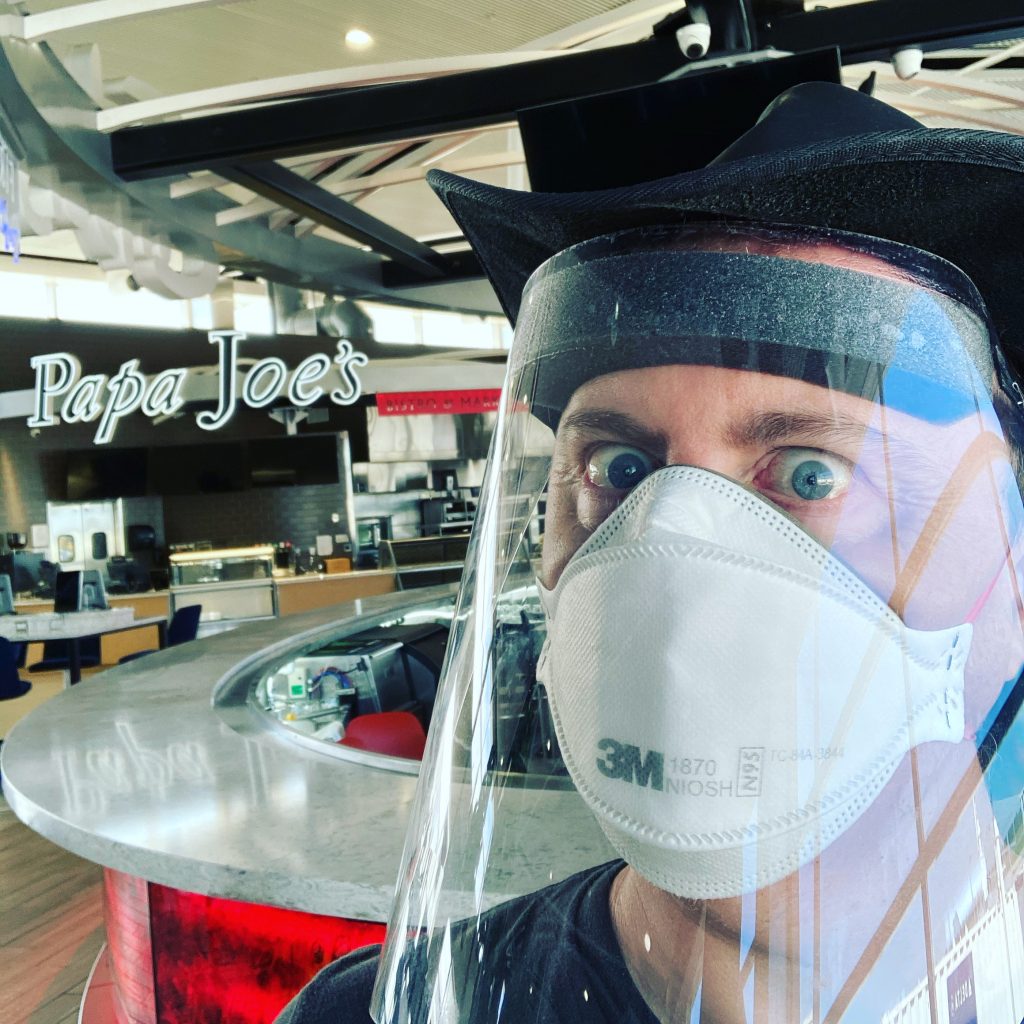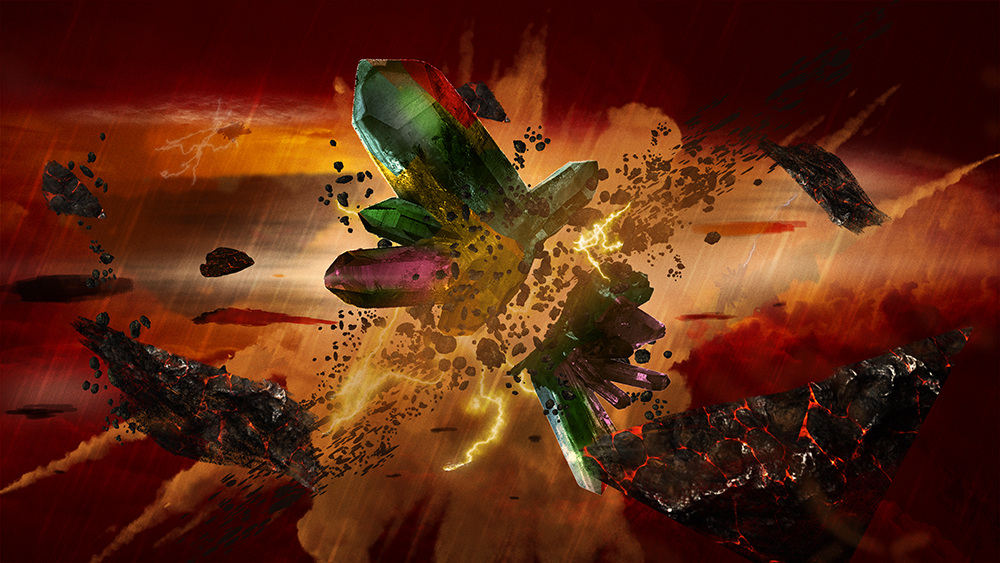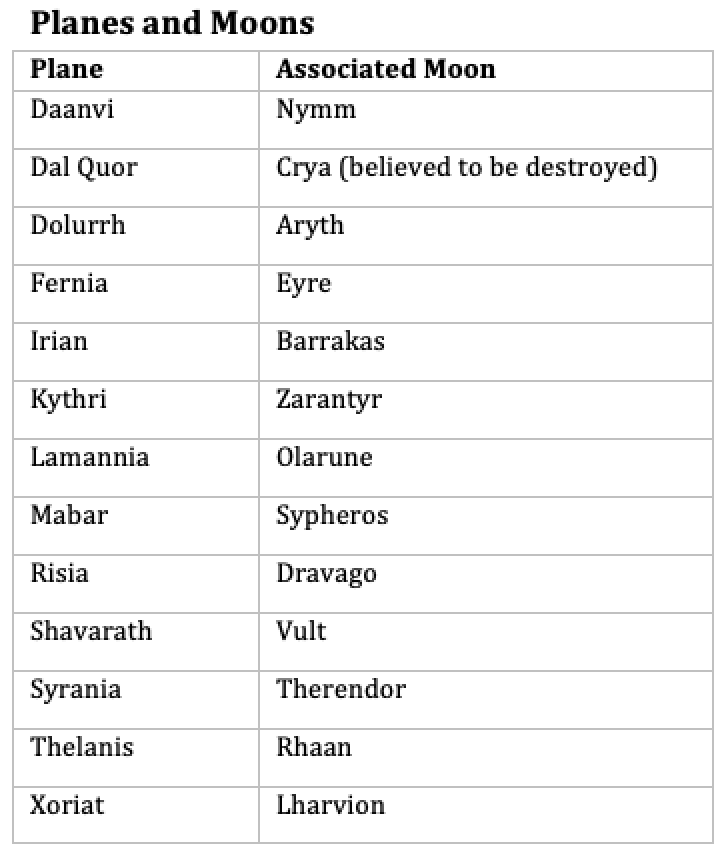
“We’re approaching the Strait of Shadows, Captain.”
With a face forged from steel, the warforged captain couldn’t scowl… but his crystalline eyes glowed brighter for a moment. “I know, Mister Darro. Get the passengers below and arm the crew. If the Cloudreavers are in the sky today, this is where they’ll strike.”
How would I handle sky piracy in Eberron? It’s a question that’s come up on my Patreon a number of times over the course of the last year, and it finally won a decisive victory in the poll to determine article topics. But it’s a tricky question, because the outright answer is that I wouldn’t explore sky piracy in canon Eberron. By canon, elemental airships have only been in service for eight years. Air travel is a very recent development and there’s just not a lot of traffic in the sky; I’d expect the most common form of aerial crime to be skyjacking. Which isn’t to say that I couldn’t or wouldn’t run a sky pirates campaign in Eberron; it’s that the first thing I’d do would be to change canon to support it. What follows are ideas I would implement for a sky pirates campaign—not just not canon, but not something I’d necessarily use in a standard kanon campaign unless I wanted air travel to play a significant role. So none of this is canon, and I may end up incorporating some of these ideas into the new setting I’m developing for Threshold. Having said that, let’s delve into the Eberron I’d run my Sky Pirates campaign in…
THE WORLD ABOVE
Look into the skies above our world and you’ll mostly find air and water—storms, clouds, and gales. You won’t find things that are solid and permanent. You won’t find lines of fire burning in the sky, or patches of eternal night. And you won’t see castles in the clouds, or chunks of stone or soil suspended in the air. In Eberron, all of those are part of the skyscape… and that’s only the beginning. Manifest zones are places where the planes bleed into the material world, and manifest zones aren’t limited to the surface of Eberron. The Strait of Shadows are a massive aerial zone tied to Mabar—a stretch of air that consumes light, creating a region of endless night filled with banks of roiling shadows. Firefalls are rifts in the sky where Fernian flame cascades down toward the surface. The flames fade before they reach the ground, but a firefall can be a deadly hazard to a vessel in the air. Here’s a few important things that can be encountered in the skies above Eberron.
Walking on the Clouds
While most of the clouds in the sky are insubstantial vapor, there are two planes that can produce solid cloudstuff. Syranian clouds are identical to mundane clouds—typical stratus or cumulus in form—but they are soft, solid, and stable. They generally lack any sort of indigenous life, making them a solid base for aerial colonization; the floating district of Skyway in Sharn is built on a foundation of Syranian cloud.
Where Syranian clouds are generally uniform in design, every Thelanian cloud is unique—each held together by a story. Mistone Keep is a massive castle, with walls formed from the same cloudstuff as the “ground” it rests upon. It’s sized for giants, but it was empty when it was found and its original owners have never returned… though some wonder if they yet may, and if so what they will make of the people of Aundair who have colonized their castle. Thunderholt is a storm cloud, with lightning forever rippling in its murky depths. The surface of the cloud is filled with canyons and caves, and there are streams of lightning in its depths. Some claim that the archfey known as the Forge Maiden has a workshop in the depths of Thunderholt, where she harnesses the lightning; it’s said that the thunder is the sound of her hammer on the forge. Silverwood is a forest growing out of the clouds. Its trees are unique; some have snowflakes budding on their branches, others bear flowers made of mist. The heart of this cloud island is a massive tree of bone, with brilliant crimson leaves; the dryad tied to this tree is an oracle, but she will only answer questions for those who water her roots with blood. These are just three examples. Some Thelanian clouds are uninhabited, like the empty castle of Mistone Keep. Some, like Silverwood, have indigenous fey that are willing to coexist with mortal settlers. Others have denizens who have no interest in sharing their islands with others. Graystorm is home to the silver dragon of the same name; while he has been dormant for centuries, in the past Graystorm has pillaged cities below and its said that his hoard contains artifacts from Dhakaan and ancient Wroaat—possibly even the axe of Malleon the Reaver. While Graystorm is mechanically a dragon, he is functionally an immortal fey and has no ties to Argonnessen, nor any interest in the Chamber or the Lords of Dust. Cloud giants are an open question. A cloud giant could follow the model of Graystorm, being an immortal Thelanian creature tied to the story of their cloud. Alternately, cloud giants could be a colonizing force who have laid claim to the clouds over Xen’drik, a few of which have made their way to Khorvaire.
Clouds spawned by manifest zones are stationary, bound to the zone that generates them. Cloudstuff will turn to vapor when removed from the zone, and a damaged cloud will regenerate over time. However, Thelanian clouds may produce unique resources that can be harvested and removed. The trees on Silverwood won’t grow anywhere else, but their fruit can be carried down to the world below.
Islands in the Sky
Lamannia sometimes projects pieces through its manifest zones, creating floating islands of soil and stone. Sometimes, these are extremely small; there are chunks of Lamannian sky-stone barely large enough for a single watchtower. Others are large enough to support entire towns, such as the seat of the Lyrandar enclave over Stormhome. Korran’s Belt is a massive field of small chunks of earth and stone found on the border of the Ironroot Mountains and the Lhazaar Principalities; sages theorize that at one point it was a single mass but that something caused it to shatter into hundreds of smaller stones. For the most part, Lamannian sky islands have the same qualities as mundane land; what’s remarkable is their ability to sustain an ecosystem even in an impossibly small space. They are essentially projections from Lamannia, and are not bound by mundane limits. A Lamannian island might have a pool of water that never runs dry, or a river that forever flows off the edge of the island and spilling down onto the world below; both are replenished from Lamannia, and have the purity imbued by the Primordial Matter trait of that plane.
Lamannian islands can be verdant and fertile, making them excellent outposts for colonies in the sky; there are a number of sky towns in the Five Nations. Smaller islands may have been claimed by a particular family; in Breland, the ir’Tains summer on Griffon Crown, an island south of Wroat. However, there are many small and remote islands that are unclaimed in the present day. Some are home to untamed beasts, including megafauna creatures; if you’re looking for a place to put a roc in Eberron, look no further. Others could have outposts from fallen civilizations that once claimed the island; a sky island over Q’barra could have relics from the ancient dragonborn empire. These small islands can be excellent havens for smugglers and sky pirates; Korran’s Belt is filled with hidden harbors, some active and some long forgotten.
Syranian Spires
Much like the Feyspires that phase in and out of alignment with Eberron, there are stories of Syranian towers appearing in the skies for brief periods of time. These towers are typically the seats of angelic dominions, holding secrets tied to the dominion’s sphere of influence. In some of these tales, explorers bargain with the master of the tower; in others, the spire appears to be abandoned. The only thing the tales agree on is that Syranian spires never stay in the material plane for long; if you find one, you’ll want to act quickly or pass it by.
Wonders and Hazards
Manifest zones usually impose one or more of the universal traits of their associated plane. As such, manifest zones related to the same plane can produce dramatically different effects. The Straits of Shadow have the Eternal Shadows trait of Mabar, but don’t consume life. On the other hand, there are stories of regions where the Hunger of Mabar trait can trigger without warning, swiftly killing living creatures and leaving shadows in their place. Such zones create graveyards of haunted airships; new ships pause to investigate the derelicts, only to suffer the same fate when the Hunger of Mabar manifests once more. Risian zones that manifest the Lethal Cold trait of the plane are eternal blizzards, but a Risian zone that has the Stagnation effect might be less obvious to observers. Kythri zones can produce bizarre, psychedelic forms of weather—and vessels that pass through these prismatic storms can be affected by the Constant Change trait of the plane, suffering unexpected transmutation effects. And in addition to having chunks of stone that simply serve as obstacles for ships, a Lamannian zone could produce intense hurricanes or storms, or even an airport Sargasso that seeks to entangle ships with rapidly growing vines. These are just a few examples; there are countless possibilities, and zones can be of any size. A massive Fernian firefall may be a major obstacle travelers have to skirt around; on the other hand, there could be a Kythri zone that’s so small it’s never actually been noticed and recorded, but it’s enough to cause trouble when your ship passes through it. These environmental manifest zones are often hazards to be avoided, but some can produce valuable resources with uses in arcane industry… while others can serve as shelters or blinds for travelers with nefarious intent.
THE SKYLINES
Islands, cloud castles, and manifest wonders all give a reason for people to reach for the sky. In canon Eberron, air travel is quite limited and dominated by House Lyrandar. And in my campaign, the elemental airship as we know it remains a recent development and the pride of House Lyrandar. But there is another form of common air travel that forms the basis of commerce and the target of piracy, and that’s tied to the Skylines. Also known as planar currents, skylines are vast, invisible channels of energy that connect major aerial manifest zones. The strongest currents weave together threads of different planes, but there are lesser currents branching off to minor the least zones.
Ships capable of traveling along the Skylines are properly called manifest vessels, though ‘airship’ remains the common word for all large air vehicles. Manifest vessels don’t hover under their own power. Instead, they are buoyed by the energy of the skyline. While within a skyline, a manifest airship is much like a submarine (immersed within the medium it travels through as opposed to traveling on the surface of it). Left untended, a manifest airship will remain suspended in the line. However, should a vessel travel out of the skyline, it will fall to the earth. The energy of the line grows weaker the closer you get to the edge, which in turn slows the ship; any capable navigator can recognize the warning signs and keep their ship safely in the current. But it is possible to sail a ship out of the current and into the open—and unsupportive—air. Skylines vary in size; the largest is about a mile in diameter, while the smallest skyline might be just fifty feet across—though they can have “shallows” extending farther for vessels willing to risk them.
The larger a vessel is, the stronger the current needs to be to support it. So while there are small skylines that connect lesser manifest zones, a large vessel can’t travel along these lines, just as a supertanker can’t travel along a stream. This means that a small, fast vessel can travel along lesser lines that trade ships can’t take—or just skirt the edges of a line, where the currents are too weak to support a larger ship, just as a water vessel would need to be careful to avoid running aground in shallow water. All of these things combine to support aerial piracy. The first element is that there are recognized, established trade routes and that large vessels have to stick to these paths. This is also how things like firefalls and the Strait of Shadows come into play. If you take the major skyline from Rekkenmark to Vedakyr, you’re going to pass over the Nightwood and the Strait of Shadows; avoiding it would require following a different set of skylines that will add a few days to your travel time, and they will likely have other hazards you’ll have to deal with. But it’s also the case that smaller vessels can travel along lesser lines—allowing them to take direct paths and also, allowing raiders to strike a ship on a main line and then flee along the lesser currents.
In setting up an aerial campaign, an important question is how ships REACH the Skylines. If you want to keep it simple, major aerial manifest zones can drop pillars down to the surface—so you can descend from Silverwood to the ground safely. On the other hand, this could be limited to specific manifest zones; for example, it could be that Syranian manifest zones like Sharn become crucial ports where major manifest vessels can descend to the surface, while in lesser zones only small ships can descend, leading to systems of tenders or away teams using skystaffs or flying mounts.
Skylines are largely stable and predictable, but manifest zones can be unpredictable. A major skyline usually has a number of minor zones along its path that fluctuate in strength, like the Mabar or Kythri zones mentioned above. Thus you can have the equivalent of weather, as a Kythri zone that’s long been dormant suddenly flares up with a prismatic storm. It’s also the case that a skyline is still subject to MUNDANE weather; when you aren’t dealing with rocs or firefalls, you’ll still have to handle thunderstorms and blizzards!
There are maps of the major skylines across Khorvaire, but there may still be skylines that have yet to be explored, especially those tied to minor currents or remote zones. Adventurers could discover a new line or be hired to accompany a vessel exploring a new line, not knowing what zones or threats they will encounter along its path.
COMMERCE AND TRAVEL
The manifest airship is the main form of traffic along the Skylines. Most manifest vessels have a top speed between ten to sixteen miles per hour. The most energy efficient way to travel is using manifest sails, which can be arranged to catch the planar currents; such vessels are typically on the slower side unless they can also harness wind. Faster ships use a manifest engine that burns dragonshards to produce motive power; House Cannith produced the first manifest engine, but the Arcane Congress produced its own form of it. House Lyrandar doesn’t have a monopoly on manifest travel, but they have produced small vessels capable of combining wind power and manifest sails, enabling them to move swiftly at lower cost than other ships.
The skylines and manifest travel are the most COMMON form of air travel, but not the only one. The timeline for the development of the elemental airship remains the same; House Lyrandar launched the first commercial airship eight years ago. With a typical cruising speed of twenty miles per hour and the ability to follow any path—completely ignoring the established skylines—the elemental airship stands ready to upset the established balance of power. However, Lyrandar’s fleet of elemental airships is still quite small, and their manifest sails are still less expensive to operate—so Lyrandar continues to sail the Skylines in addition to charting new paths with their elemental ships.
While manifest ships remain the most reliable way to travel over long distances, there are many short-range options and flying mounts. This article discusses some of those. I’d make skystaffs (brooms of flying, just not shaped like brooms) more widespread in a campaign with a strong aerial focus. Hippogriffs have long been the traditional canon mount, though fifth edition swapped the balance and made hippogriffs slower than both griffons and giant eagles; if you want to preserve the older balance, you could introduce a Vadalis hippogriff that has an flight speed of 90 ft but only inflicts 1d8 with its bite attack and 2d4 with its claws. Likewise, Syranian manifest zones that enhance flight—like the zone in Sharn and most regions with Syranian clouds—will support skycoaches and other local flying vehicles. As a note, if you find that the speeds of the ships feel too slow, feel free to increase them. A modern cruise ship travels at an average speed of 20 miles per hour, and I’m using naval speeds as a benchmark here. I could see doubling those speeds, but if you get to the sorts of speeds we see in modern air travel, among other things, ships don’t stay in the air that long and you don’t have as much opportunity for piracy!
So in this version of the setting, Skylines become a secondary form of river—paths that connect communities and serve as paths of transit and commerce. Many major cities are built near or under Syranian clouds or Lamannian islands, while other sky islands serve as hubs in their own right. In this version of the setting, Arcanix was built in its current location rather than being moved; if Aundair DID seize Arcanix from Thrane during the war (as presented in canon history), it likely belongs to Aundair/Thaliost at some previous point and was lost to some form of bureaucratic motion during the long history of Galifar. Had I time, I would go deeper into the flavor of the skies of each nation. I’ve always called out Aundair as having strong ties to Thelanis, which would make Thelanian clouds more common there. Karrnath is home to the Strait of Shadows and other Mabaran zones, and I would see it having some rocky Lamannian islands; Breland has more Syrannian clouds and a few resource-rich Lamannian islands that are being harvested to support its industry. The Lhazaar Principalities are home to Korran’s Belt and other small islands—some claimed by Principalities, others left empty. Which brings us to…
PIRATES AND ADVENTURERS
In this vision of the setting, air travel is a common activity. Lyrandar has the fastest and most efficient ships, but every nation has ships in the air, along with countless independent merchants. The Skylines create established shipping lanes… which in turn create targets for piracy. It’s up to the DM to decide just how crowded the sky is. It could be that sky islands are relatively rare, or it could be that formations like Korran’s Belt are actually found across Khorvaire; if these Lamannian chains have valuable (and possibly renewable) resources, sky mining could be an important commercial activity.
With this in mind, sky piracy would operate much like piracy on the sea. Pirates would find vulnerable spots in the shipping lanes, places where it’s easy for a raiding ship to hide. Pirates would likely use smaller manifest vessels, focusing on speed and the ability to go into shallow currents or along lesser lines where other ships couldn’t follow. On the other hand, you could easily have gangs of skystaff raiders or beast riders operating over short distances, boarding a vessel and then seizing control of it to take it to a nearby friendly port. I can also imagine a well-established Skyline that runs through particularly dangerous territory—with a significant number of mini-Kythri zones generating prismatic storms, Mabaran graveyards, chunks of Lamannian rock that are barren but dangerous—which is thus shunned by legitimate travelers but has become a haven for smugglers, pirates, and others willing to run the dangerous path. Let’s call that The Gray Road—and saying that someone “takes the Gray Road” is a slang term for up to no good. And again, the places where the Gray Road intersects with other skylines would be prime spots for piracy.
In general, the principle of the Gray Road gives room for adventure. There can be known skylines that aren’t used by commercial traffic because they’re just too dangerous—so people know about paths that ships can take, but they haven’t been thoroughly explored. Beyond this, there can be lesser lanes that can’t support large ships… but the player characters have obtained a revolutionary vessel that can stay aloft in the shadows, and they’ve been charged to do some exploration and trailblazing. What’s the story of that Thelanian island? Can you steal an artifact from Graystorm’s hoard? Alternately, adventurers can be bounty hunters or privateers, venturing down the Gray Road or into other dangerous currents in pursuit of known pirates or war criminals.
Looking to pirates, the simplest thing is to make use of the pirates we already know. The Lhazaar Principalities raid the seas because that’s all that’s available. But in this campaign, the Principalities could extend into the air. The Wind Whisperers might have the fastest ships, but the Cloudreavers could be the most brutal of the sky raiders. And despite the captain’s comment in the opening quote, the Bloodsails would likely love to linger in Mabaran zones like the Strait of Shadows. Over Droaam you’ll have to worry about harpies and gargoyles, not to mention the concept of a wyvern-riding Dassk force. In the Mror Holds there could be a gang of manticore-riding brigands. And worst of all, who knows what’s become of the skies over the Mournland? Have the effects of the Mourning destroyed the skylines above Cyre, or have they been transformed or seeded with monsters?
Obviously this is only the tip of the floating iceberg, but I’m afraid it’s all the time I have for the topic. You may want to read my article on Airships or Flight in Eberron, though neither considers the concept of widespread flight. As always, thanks to my Patreon supporters for choosing the topic and making these articles possible!

 Unlock with Patreon
Unlock with Patreon



